Kodava language
The Kodava (Kodava: [koɖɐʋɐ]) (Kodava takk, Kodava: [koɖɐʋɐ t̪ɐkːɨ], meaning 'speech of Kodavas', in the Kodava language, alternate name: Codava, Coorgi, Kodagu) is an endangered[3] Dravidian language and it is spoken in Kodagu district in Southern Karnataka, India. The term Kodava has two related usages. Firstly, it is the name of the Kodava language and culture followed by a number of communities from Kodagu. Secondly, within the Kodava-speaking communities and region (Kodagu), it is a demonym for the dominant Kodava people. Hence, the Kodava language is not only the primary language of the Kodavas but also of many other castes and tribes in Kodagu. The language has two dialects: Mendele (spoken in Northern and Central Kodagu, i.e. outside Kodagu's Kiggat naadu) and Kiggat (spoken in Kiggat naadu, in Southern Kodagu).
| Kodava | |
|---|---|
| Coorg, Kodagu | |
| Native to | India |
| Region | Kodagu |
| Ethnicity | Kodava |
Native speakers | 113,857 (2011 census)[1] |
| Kannada Script, Kodava Script, Malayalam Script | |
| Official status | |
| Regulated by | Karnataka Kodava Sahitya Academy |
| Language codes | |
| ISO 639-3 | kfa |
| Glottolog | koda1255 |
| ELP | Kodagu |
 | |
| Part of a series on the |
| Culture of Karnataka |
|---|
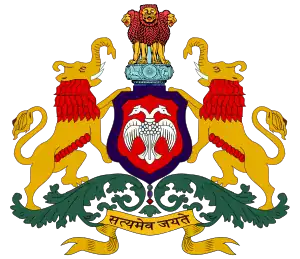 |
Historically, it has been referred to as a dialect of Centmil, in some Tamil texts the Kodagu language is referred to as Kudakan Tamil.[4] However, it has been re-analysed as a language by early 20th century academics. Now it is considered as an intermediate language between Kannada, Malayalam, Tamil, and Tulu in comparative linguistics.[4]
It is traditionally written using the thirke script which is an abugida.[5][6] The 2011 Census of India reports 96,918 persons who returned Kodava as their mother tongue and 16,939 who returned Coorgi/Kodagu, for a total of 113,857 persons coming under the parent group which is again identified as Coorgi/Kodagu (another name for Kodava) as the mother tongue.[7]
History

In Kannada, the region was called Kodagu and the people Kodaga. Natively, the people were called Kodava and the land was called Kodavu in the folksongs. Comparative Dravidian studies show that the Kodava language belongs to the South Dravidian language group.[8][9]
Grammar
The grammar of Kodagu has been systematically studied and documented since at least around 1867 when Captain R.A. Cole published the seminal work An Elementary Grammar of the Coorg Language.[10]
Phonology
Vowels
Dravidian vowel systems contain five vowel qualities i.e. those usually corresponding to a, e, i, o and u., with a short and long variants for each. However, Kodava has two more: the mid and high (close) back unrounded vowels, with corresponding long variants.[11]
Kodagu has 14 vowels. 7 of these, i, e, ɛ, a, ɑ, o, u have long equivalents.[12]
| Front | Central | Back | |
|---|---|---|---|
| Close | i | ɨ | u |
| Close-mid | e | ə | o |
| Open | a |
Consonants
Kodava has 25 consonants.
| Bilabial | Dental | Alveolar | Retroflex | Palatal | Velar | Glottal | ||
|---|---|---|---|---|---|---|---|---|
| Nasal | m | n̪ | ɳ | ɲ | ŋ | |||
| Stop | voiceless | p | t̪ | ʈ | c | k | ||
| voiced | b | d̪ | ɖ | ɟ | g | |||
| Fricative | s | ʂ | ʃ | h | ||||
| Approximant | ʋ | l | ɭ | j | ||||
| Trill | r | |||||||
Kodava and Kannada share a lack of palatalization of word-initial *k-, which is a feature found in the Tamil-Malayalam branch.[14]
Writing system

Dr. IM Muthanna, developed a script to Kodava Thakk in 1971, and as of 2022, Karnataka Kodava Sahitya Academy, a government body for the development of Kodava Language, accepted the script developed by Dr IM Muthanna as the official script of Kodava Language. It is also widely used across Kodagu, Although around 7 scripts were developed over a period from 1889 to 2008, Only Dr. IM Muthanna's script is considered as the most acceptable script for Kodava Language.
The Coorgi is an alphabet developed by the linguist Gregg M. Cox[15] that is used by a number of individuals within Kodagu district of India to write the endangered Dravidian language of Kodava, also known sometimes as Coorgi.[16]
The script uses a combination of 26 consonant letters, eight vowel letters and a diphthong marker. Each letter represents a single sound and there are no capital letters.[15] A computer-based font has been created.[17] The script was developed out of the request by a group of Kodava individuals to have a distinct script for Kodava Takk, to distinguish the language. Kodava Takk is generally written in the Kannada script, but can also be found written in the Malayalam script, especially along the borders with Kerala. The new script is intended as a unified writing system for all Kodava Takk speakers.[18]
Comparisons
Linguistically, Kodava/Kodagu language belongs to the South Dravidian subfamily of the Dravidian family. Further within the South Dravidian subfamily, it belongs to the subgroup Tamil-Malayalam-Kodagu-Kota-Toda.[19] It is closely related to and influenced by Kannada, Malayalam, Tamil and Tulu. A majority of the words are common between Kodava and Beary bashe, a dialect which is a mixture of Tulu and Malayalam spoken by the Beary Muslims and Kodava Thiyyar communities. Kodava is also closely related to the Kasaragod and Kannur dialects of Malayalam, which are in turn related to Beary.
Literature
Family histories, rituals and other records were scripted on palm leaves called Pattole (patt=palm, ole=leaf) by astrologers in the ancient times. When Kodava was written, it was usually with Kannada script, sometimes with minor modifications. The folk songs of the Kodavas, called the Palame (also known as the Balo Patt or Dudi Patt), were orally transmitted across several generations. The language had no significant written literature until the twentieth century. Appachcha Kavi, a playwright, and Nadikerianda Chinnappa, a folk compiler, are the two important poets and writers of the Kodava language. Other important writers in the language were B D Ganapathy and I M Muthanna. In 2005, after requests from the Kodagu community, German linguist Gerard Cox created a script unique to Kodava called the Coorgi-Cox script. It uses straight lines for 5 vowels, and has circles for diphthongs.[20]
The Pattole Palame, a collection of Kodava folksongs and traditions compiled in the early 1900s by Nadikerianda Chinnappa, was first published in 1924. The most important Kodava literature, it is said to be one of the earliest, if not the earliest, collection of folklore of a community in an Indian language. Nearly two-thirds of the book consists of folksongs that were handed down orally through generations, sung even today during marriage and death ceremonies and during festivals relating to the seasons and in honour of local deities and heroes. Traditionally known as Balo Pat, these songs are sung by four men who beat dudis (drums) as they sing. Kodava folk dances are performed to the beat of many of these songs. The Pattole Palame was written using the Kannada script originally; it has been translated into English by Boverianda Nanjamma and Chinnappa, grandchildren of Nadikerianda Chinnappa, and has been published by Rupa & Co., New Delhi.[21]
Cinema
The Kodava Cinema industry is very small. A few movies portraying the native culture and traditions of the Kodavas have been produced in this language. The first Kodava film 'Nada Mann Nada Kool' was directed by S.R.Rajan and produced in the year 1972.
Kodava words
| Kodava | Kannada | Tamil | Malayalam | Tulu | English |
|---|---|---|---|---|---|
| Moodi | Hudugi | Peṇ/Peḍai/Ponnŭ | Penkutti | Ponnu | Girl |
| Kinha | Huduga | Aan/Peḍiyan/Paiyan/Chiruvan | Aankutti | Aan/Kinni | Boy |
| Po(Singular); Poyi(Plural) | Hogu | Pō(y) | Poyko | Poyi | Go |
| Kanni | Saaru/ganji | Kañji/Kūṭṭŭ/Chārŭ | Chaar | Kajipu | Stew (lentils, vegetables, etc.) |
| Koole | Anna/Koolu | Chōr/Kūḻ | Chor | Nuppu | Cooked Rice |
| Id | Idu | Iḍŭ/Vai | Ide | Dee | Put |
| Thimbak | Tinnakke | Thinnŭ/Uṇṇŭ/Sāppiḍŭ | Tinnuka/Kazhikkuka | Thinere | To Eat |
| kuLi | snana | kuLi | kuLi | Meela | To Bath |
| Unda? | Unta/ideya? | Uṇḍā?/Irukkuthā? | Undo? | Unda? | Is There? |
| Bappi | Bartini | Va(ruki)ṟēn/Varuvēn | Varam | Barpe | I will Come (Farewell Greeting) |
| Ullo | iddene/ulle | irukkiṟēn/uḷḷēn | Ulle | Ulle | Am There |
| Bandan Ullo | Baruta iddene | Va(ruki)ṟēn | Varunnund | Barond ulle | Am coming |
| Yenene Ulliya? | Hege iddiya? | Eppaḍi/Enneṇdŭ (uḷḷ-/irukkiṟ-)(-ai/-āi/-īrgaḷ) | Engane und? | Encha ulla/ya? | How are you? |
| Māṅge | Maavu | Māṅgā(y)/Māmpaḻam | Māṅga/Māmpaḻam | Mudi/Kukku | Mango |
| Kaḷḷa | Kaḷla | Kaḷḷan/Kaḷvan/Thiruḍan | Kaḷḷan | Kalva | Thief |
| Suroole /Minyathele | Modalu/Suroonalli | Mudal(il) | Adyam | Suru | First |
| Kere Pamb | Kere Haavu | Chārai Pāmbŭ | Chēra Pamb | Keri | Rat Snake |
| Mūle | Mūle | Mūlai | Mūla | Mudye/mūle | Corner |
| Āme | Āme | Āmai | Āma | Eme | Tortoise |
| Bēli | Bēli | Vēli | Vēli | Bēli | Fence |
| Bithe/Kuru | Beeja/bitha | Vitthŭ/Vithai | Vitth/Kuru | Bitth | Seed |
| Bādege | Bādige | Vādakai | Vādaka | Badige | Rent |
| Chaththe | Sante | Chanthai | Chantha | Santhe | Market |
| Ēni | Ēni | Ēṇi | Ēṇi | Ēni | Ladder |
| Pulunja Puḷi | Hunase Huli | PuLi | PuLi | Punke puli | Tamarind |
| Gaali/Kaath | Gaali | Kāṟṟŭ/Kāththŭ | Kaatt | Gaali | Wind |
| Thaari | Kodu/tha | Tharŭ/Koḍŭ | Tharu | Koru | give |
| Kaapi | Kaapi | Kaapi | Kaapi | Kaapi | Coffee |
| Paaduvo | Haadu | Paadŭ | Paaduka | Pada paad | to sing |
Script examples

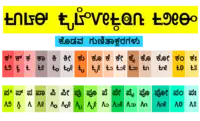 Kodava Vowels - Gunithaakshara
Kodava Vowels - Gunithaakshara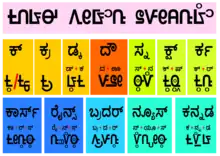 Kodava Language Grammer
Kodava Language Grammer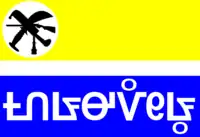 Unofficial Flag of Kodava Naad
Unofficial Flag of Kodava Naad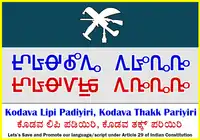 Banner in Kodava Script
Banner in Kodava Script Kodava Naad Sticker in Kodava Language
Kodava Naad Sticker in Kodava Language Word "President" written in Official Kodava Script.
Word "President" written in Official Kodava Script.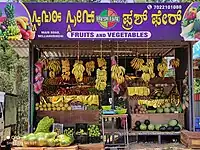 A Board in Kodava Script at Kushalnagar
A Board in Kodava Script at Kushalnagar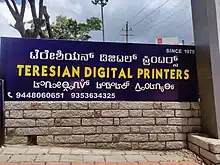 Kodava Script Board at Virajpet
Kodava Script Board at Virajpet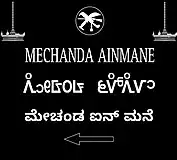 Kodava Language in a Granite Board at Kakkabe
Kodava Language in a Granite Board at Kakkabe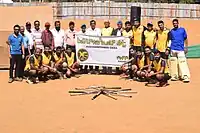 Display in Kodava Script Board
Display in Kodava Script Board
Words for family members
| Mother | Avvo |
| Father | Appo |
| Grandfather | Ajjo |
| Grandmother | Ajjavo Thaayi |
| Maternal Uncle / Paternal Aunt's husband | Thammaavo / Maavo |
| Maternal Uncle's wife / Paternal Aunt | Maavi / Thammaavi |
| Eldest Paternal Uncle / Eldest Maternal Aunt's husband | Baliappo |
| Eldest Paternal Uncle's wife / Eldest Maternal Aunt | Baliavvo |
| Elder Paternal Uncle / Elder Maternal Aunt's husband | Bojappo |
| Elder Paternal Uncle's wife / Elder Maternal Aunt | Bojavvo |
| Younger Paternal Uncle / Younger Maternal Aunt's husband | Kunjappo |
| Younger Paternal Uncle's wife/ Younger Maternal Aunt | Kunjavvo |
| Youngest Paternal Uncle / Youngest Maternal Aunt's husband | Cheriappo |
| Youngest Paternal Uncle's wife/ Youngest Maternal Aunt | Cheriavvo |
| Father-in-law | Maavo |
| Mother-in-law | Maavi |
| brother-in-law (elder) / cross-cousin (elder, brother) / lineal cousin (elder, sister)'s husband | Baavo |
| sister-in-law (elder)/ cross-cousin (elder, sister) / lineal-cousin (elder, brother)'s wife | Mammo |
| brother (elder) / lineal cousin (elder brother) / cross-cousin (elder, sister)'s husband | Anno / Annaiah |
| sister (elder) / lineal-cousin (elder, sister) / cross-cousin (elder, brother)'s wife | Akko / Akkaiah |
| brother (younger) | Thammanno |
| sister (younger) | Thange |
| Wife | Ponne |
| Husband | Wadiyye |
| Son | Movo |
| Daughter | Mova |
Recent developments
Since 2021, the Mangalore University teaches an MA degree in the Kodava language.[22]
References
- "Census of India Website : Office of the Registrar General & Census Commissioner, India". censusindia.gov.in. Retrieved 5 July 2018.
- "Dravidian". Ethnologue. Archived from the original on 16 April 2017.
- "Five Languages in Karnataka, Including Tulu Vanishing: Unesco". www.daijiworld.com. Retrieved 18 September 2020.
- Thurston, Edgar (16 June 2011). The Madras Presidency with Mysore, Coorg and the Associated States. Cambridge University Press. ISBN 978-1-107-60068-3.
- Kushalappa, Mookonda (24 January 2022). "Discovering alphabets of old Kodava script". Star of Mysore. Retrieved 13 December 2022.
- Kushalappa, Mookonda (4 February 2022). "The discovery of an old alphabet". Deccan Herald. Mysore Printers. Retrieved 13 December 2022.
- "Census of India 2011" (PDF). Census of India : Office of the Registrar General & Census Commissioner, India. Retrieved 24 January 2020.
- Rajyashree, K S. "Language in India: Kodava speech community - an ethnolinguistic study". www.languageinindia.com. Retrieved 30 May 2022.
- "KODAVA THAKK , AN INDEPENDENT LANGUAGE , NOT A DIALECT – Kodavas". Kodavas.in. Retrieved 30 May 2022.
- "Coorg Grammar". 11 August 1867 – via Internet Archive.
- Emeneau, M. B. (1970). "Koḍagu Vowels". Journal of the American Oriental Society. 90 (1): 145–158. doi:10.2307/598436. ISSN 0003-0279. JSTOR 598436.
- "PHOIBLE Online -". phoible.org. Retrieved 26 January 2019.
- Bhadriraju Krishnamurti (2003), p. 64.
- Emeneau, M. B. (1967). "The South Dravidian Languages". Journal of the American Oriental Society. 87 (4): 365–413. doi:10.2307/597585. ISSN 0003-0279. JSTOR 597585.
- Pandey, Anshuman (22 June 2012). Introducing the Coorgi-Cox Alphabet (PDF) (Report).
- "Debate on Kodava script continues". The Hindu. 12 March 2006. Archived from the original on 1 December 2007. Retrieved 29 December 2011.
- The Coorgi-Cox handbook, Feb. 2005.
- Gregg Cox, April 2005.
- Bhadriraju Krishnamurti (2003), p. 21.
- Merritt, Anne (1 April 2015). "Easiest written languages for English speakers". The Daily Telegraph. ISSN 0307-1235. Retrieved 14 October 2017.
- "Official Website of Kodava Community". Kodava.org. Retrieved 1 June 2012.
- "Mangalore University to offer MA in Kodava language". Deccan Herald. 17 December 2021. Retrieved 30 May 2022.
Bibliography
- Cole, R A (1867). An Elementary Grammar of the Coorg Language. Bangalore: Wesleyan Mission Press. Retrieved 24 August 2022.
- Bhadriraju Krishnamurti (2003). The Dravidian Languages. Cambridge Language Surveys. Cambridge University Press. ISBN 0-521-77111-0.
Further reading
- Government of Coorg (1953), Handbook of Coorg Census-1951 (PDF), Assistant Commissioner and District Census Officer, Coorg
